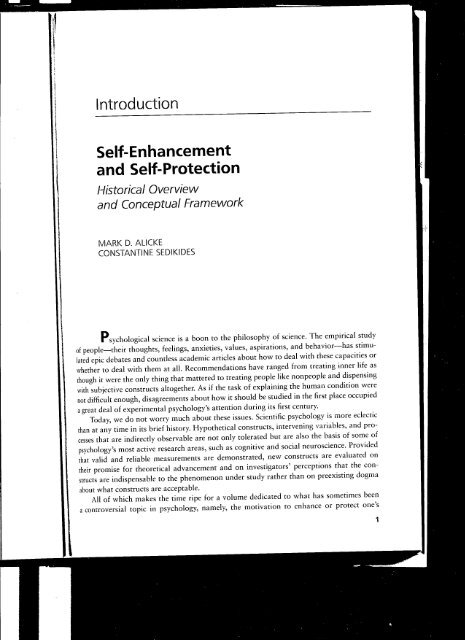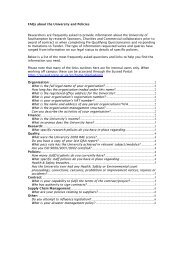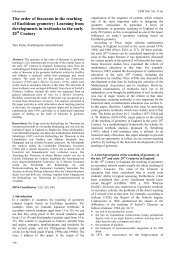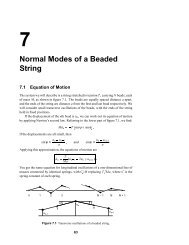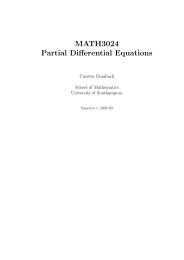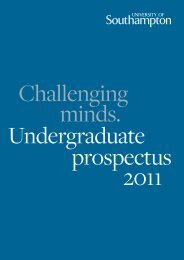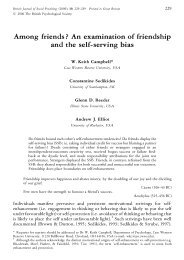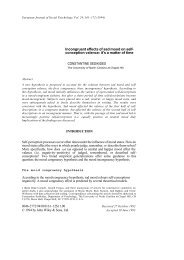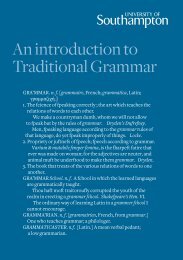Self-Enhancement and Self-Protection - University of Southampton
Self-Enhancement and Self-Protection - University of Southampton
Self-Enhancement and Self-Protection - University of Southampton
Create successful ePaper yourself
Turn your PDF publications into a flip-book with our unique Google optimized e-Paper software.
Introduction<br />
<strong>Self</strong>-<strong>Enhancement</strong><br />
<strong>and</strong> <strong>Self</strong>-<strong>Protection</strong><br />
Historical Overview<br />
<strong>and</strong> Conceptual Framework<br />
MARK D. ALICKE<br />
CONSTANTINE SEDIKIDES<br />
• sychological science is a boon to the philosophy <strong>of</strong> science. The empirical study<br />
<strong>of</strong> people—their thoughts, feelings, anxieties, values, aspirations, <strong>and</strong> behavior—has stimulated<br />
epic debates <strong>and</strong> countless academic articles about how to deal with these capacities or<br />
whether to deal with them at all. Recommendations have ranged from treating inner life as<br />
though it were the only thing that mattered to treating people like nonpeople <strong>and</strong> dispensing<br />
with subjective constructs altogether. As if the task <strong>of</strong> explaining the human condition were<br />
not difficult enough, disagreements about how it should be studied in the first place occupied<br />
a great deal <strong>of</strong> experimental psychology's attention during its first century.<br />
Today, we do not worry much about these issues. Scientific psychology is more eclectic<br />
than at any time in its brief history. Hypothetical constructs, intervening variables, <strong>and</strong> processes<br />
that are indirectly observable are not only tolerated but are also the basis <strong>of</strong> some <strong>of</strong><br />
psychology's most active research areas, such as cognitive <strong>and</strong> social neuroscience. Provided<br />
that valid <strong>and</strong> reliable measurements are demonstrated, new constructs are evaluated on<br />
their promise for theoretical advancement <strong>and</strong> on investigators' perceptions that the constructs<br />
are indispensable to the phenomenon under study rather than on preexisting dogma<br />
about what constructs are acceptable.<br />
All <strong>of</strong> which makes the time ripe for a volume dedicated to what has sometimes been<br />
a controversial topic in psychology, namely, the motivation to enhance or protect one's
2 Introduction<br />
self-image—which, following convention, we label as self-enhancement <strong>and</strong> self-protection,<br />
respectively. Whereas self-enhancement refers to a tendency to claim greater st<strong>and</strong>ing on a<br />
characteristic, or more credit, than is objectively warranted, self-protection refers to tactics<br />
that are adopted to avoid falling below a desired st<strong>and</strong>ard (Alicke &c Sedikides, 2009).<br />
Despite being subject to periodic critiques, self-enhancement <strong>and</strong> self-protection motivations<br />
have been among the most actively researched topics by social <strong>and</strong> personality psychologists,<br />
perhaps more actively researched at present than at any previous time.<br />
So why have these constructs, which psychologists deem so vital <strong>and</strong> which are mainstays<br />
<strong>of</strong> literary <strong>and</strong> artistic conceptions <strong>of</strong> human life, been intermittently suspect in scientific<br />
psychology? One possibility is their historical association with Freudian theory. The<br />
defense mechanisms posited by Sigmund Freud (1915/1961a, 1923/1961b, 1926/1961c) <strong>and</strong><br />
Anna Freud (1936/1946) provided the first important discussion <strong>of</strong> such issues in psychology.<br />
Whereas few would deny the operation <strong>of</strong> psychological tendencies such as repression,<br />
projection, displacement, <strong>and</strong> rationalization (Baumeister, Dale, & Sommer, 1998; Cramer,<br />
2000; Schimel, Greenberg, & Martens, 2003), the Freudian conception contains dubious <strong>and</strong><br />
difficult to validate assumptions about their unconscious <strong>and</strong> sexual nature that diminishes<br />
their scientific utility.<br />
Moreover, given that they belong to the family <strong>of</strong> motivational constructs, self-enhancement<br />
<strong>and</strong> self-protection were subject to the same onslaught as were all motivational constructs<br />
during the heyday <strong>of</strong> radical behaviorism. Skinner (1953) thought <strong>of</strong> self-enhancement<br />
<strong>and</strong> self-protection as Freudian-type constructs that occurred in a mythical unconscious<br />
mind—which is to say that he did not think much <strong>of</strong> them at all. Skinner lost his battle,<br />
as it became increasingly clear that reliable <strong>and</strong> valid measurement, along with theoretical<br />
efficacy, were the main touchstones for the scientific usefulness <strong>of</strong> a construct. All sciences<br />
make extensive use <strong>of</strong> unobservables (e.g., "force" in physics), <strong>and</strong> many formerly unobservable<br />
constructs in psychology have become observable with advances in technology. Perhaps<br />
the single most damning criticism <strong>of</strong> the radical behaviorist enterprise was the recognition<br />
that behavior itself is a construct to be explained. So, although a person who is "swinging<br />
an axe" appears to be enacting a behavior that can be taken at face value, whereas a person<br />
who is "acting defensively" is seen as doing something that requires further interpretation,<br />
the matter is not quite so simple. A person swinging an axe might be described as building<br />
a canoe, getting exercise, working out his frustrations, destroying his neighbor's property,<br />
doing his neighbor a favor, or committing a crime. Simply stating that he is swinging an axe<br />
is uninformative at best <strong>and</strong> may be misleading or inaccurate. In short, whether the event<br />
to be explained is swinging an axe, feeling insulted, exaggerating one's abilities, or taking<br />
undeserved credit for an assignment, the motives underlying these events are relevant to an<br />
accurate characterization.<br />
Although Skinner (1953) eschewed most "internal" events, he began his career doing<br />
physiological research <strong>and</strong> could never quite bring himself around to deny the importance<br />
<strong>of</strong> genetics on behavior. It was his perception that internal events were resistant to empirical<br />
study that troubled him more than their existence, <strong>and</strong> it was the motivation construct above<br />
all that aroused his ire. To be fair, there was good reason for his dyspepsia. During the 1950s,<br />
exquisitely complex motivational mechanisms dominated behavior theories so that even the<br />
simplest actions were explained by convoluted processes with scant empirical support. Radical<br />
behaviorism waned as the study <strong>of</strong> cognition <strong>and</strong> language waxed, but, during its ascendance,<br />
it was a useful corrective for motivational theories run amok.
Introduction 3<br />
>rotection,<br />
siding on a<br />
:ers to tacks,<br />
2009).<br />
Motivations<br />
chologists,<br />
i are mainpect<br />
in sciheory.<br />
The<br />
1961c) <strong>and</strong><br />
in psycholrepression,<br />
'8; Cramer,<br />
ubious <strong>and</strong><br />
diminishes<br />
:lf-enhanceraonal<br />
conilf-enhancemconscious<br />
t his battle,<br />
theoretical<br />
All sciences<br />
y unobservigy.<br />
Perhaps<br />
recognition<br />
swinging<br />
as a person<br />
erpretation,<br />
as building<br />
•'s property,<br />
ging an axe<br />
er the event<br />
s, or taking<br />
levant to an<br />
:areer doing<br />
importance<br />
to empirical<br />
struct above<br />
g the 1950s,<br />
bat even the<br />
pport. Rading<br />
its ascen-<br />
A final reason that self-enhancement <strong>and</strong> self-protection explanations have been met<br />
with resistance is that they seem to violate William <strong>of</strong> Ockham's (c. 1287-1347) dictum<br />
to favor explanations with fewer theoretical mechanisms (Spade, 2006). Ockham's "razor"<br />
was actually intended to eliminate theological assumptions from nascent scientific explanations,<br />
but its greatest legacy is the proposition that the simpler <strong>of</strong> otherwise identical theoretical<br />
explanations should be preferred (Thorburn, 1918). There are, however, no inherent<br />
complexities in self-enhancement <strong>and</strong> self-protection mechanisms to discourage their use in<br />
scientific explanations.<br />
Despite their central role in human behavior <strong>and</strong> social relations, no single volume has<br />
been dedicated to self-enhancement <strong>and</strong> self-protection as they are represented in psychological<br />
theory <strong>and</strong> research. Our goal in this h<strong>and</strong>book is to provide a comprehensive survey <strong>of</strong> research<br />
areas in which self-enhancement <strong>and</strong> self-protection explanations play an important role. To put<br />
the study <strong>of</strong> self-enhancement <strong>and</strong> self-protection in context, we begin by examining briefly the<br />
emergence <strong>of</strong> the motivation concept, then trace its introduction into psychological theories,<br />
<strong>and</strong> finally describe its deployment in self-enhancement <strong>and</strong> self-protection theories.<br />
The Motivation Construct Emerges<br />
Although self-enhancement <strong>and</strong> self-protection are complex motives, they have at their roots<br />
the assumption that people want to feel good, or avoid feeling bad, about themselves. In<br />
this regard, the self-enhancement <strong>and</strong> self-protection motives are consistent with the earliest<br />
conjectures about what drives human action, namely, that hedonism was at the helm.<br />
The hedonism construct entered Western thought with the writings <strong>of</strong> the Cyrenaic <strong>and</strong><br />
Epicurean philosophers. The founders <strong>of</strong> these schools <strong>of</strong> thought, Aristippus <strong>and</strong> Epicurus,<br />
respectively, emphasized the pursuit <strong>of</strong> pleasure over anything else (including traditional conceptions<br />
<strong>of</strong> virtue) <strong>and</strong> painted a picture <strong>of</strong> humans as pleasure seeking <strong>and</strong> pain avoidant<br />
(DeWitt, 1973; Tatarkiewicz, 1976).<br />
The dominant role <strong>of</strong> hedonism as the master motive in human affairs receded for<br />
a time while rationalist philosophies were in ascendance. Rationalism depicted an objective<br />
reality that all people with correct underst<strong>and</strong>ing (literally, "orthodoxy") could discern<br />
(Kenny, 1986; Loeb, 1981). According to the continental rationalists (Descartes, Spinoza,<br />
Leibniz), for example, irresponsible, malicious, selfish, or foolish actions stemmed from<br />
faulty knowledge—a view that echoed Plato's ideas (The Republic, trans. 1991). If there<br />
were a master motive for the rationalists, therefore, it would be to obtain correct knowledge,<br />
<strong>and</strong> the failure to behave morally, or in a way that ultimately advanced personal <strong>and</strong><br />
societal goals, was due to inadequate underst<strong>and</strong>ing.<br />
Hedonism reemerged as the dominant perspective with the rise <strong>of</strong> British empiricism in<br />
Engl<strong>and</strong> in the late 16th century. For Hobbes, behavior was driven by the unbridled pursuit<br />
<strong>of</strong> pleasure rather than by a failure to grasp a priori truths. Experience, which could confer a<br />
range <strong>of</strong> salutary or destructive motives, became the key to underst<strong>and</strong>ing behavior. In short,<br />
empiricists (e.g., John Locke, David Hartley, James Mill) substituted learned associations for<br />
innate knowledge, <strong>and</strong> Hobbes (<strong>and</strong> later the utilitarians, particularly Bentham) supplanted<br />
rationality with desire. With desire reestablished at the forefront <strong>and</strong> the role <strong>of</strong> experience<br />
or learning recognized as the key to underst<strong>and</strong>ing behavior, the early foundation for motivation<br />
research was laid (G<strong>of</strong>er & Appley, 1964; Macfarlane, 1978).
4 Introduction<br />
Motivation in Psychology<br />
With the notable exception <strong>of</strong> the aforementioned radical behaviorists, most psychologists<br />
have readily embraced motivational constructs <strong>and</strong> theories. Motivation has been used in<br />
three essential ways in psychology. First, motivation accounts for fluctuations in how much<br />
energy is exerted toward a goal. Skinner (1953) proposed that learning, deprivation, <strong>and</strong><br />
genetic endowment could account for these differences, but even most behaviorists invoked<br />
energization or drive constructs to account for variations in behavior strength (Atkinson,<br />
1960; Dollard & Miller, 1950; Hull, 1943). In fact, these early learning theories contributed<br />
some <strong>of</strong> the most comprehensive motivational perspectives that have emerged in psychol-<br />
ogy-<br />
The second conceptualization <strong>of</strong> motivation is as directive or purposive. Whereas energization<br />
refers to variations in how hard the organism is working, the directive component<br />
explains what the organism is trying to accomplish. This aspect <strong>of</strong> motivation is represented<br />
in ordinary concepts, such as desires, preferences, goals, wishes, values, wants, <strong>and</strong> needs<br />
(Higgins & Sorrentino, 1996; Schwartz, 1992; Shah, Kruglanski, & Friedman, 2002). The<br />
directive or purposive component accounts for the fact that identical stimulus conditions can<br />
produce dramatically different responses. A pair <strong>of</strong> identical twins, for example, imbued with<br />
the same genetic constitution <strong>and</strong> deprived <strong>of</strong> food for the same period, might respond very<br />
differently to the sight <strong>of</strong> triple-chocolate ice cream. Although a staunch behaviorist would<br />
argue that preferences are written in people's reinforcement histories, practical limitations<br />
make it virtually impossible to identify all the past <strong>and</strong> present contingencies that govern<br />
behavior. Thus alluding to the reasons for which people acted or to the desires that impelled<br />
them substitutes for complete knowledge <strong>of</strong> their reinforcement histories.<br />
The third prominent use <strong>of</strong> the motivation construct is to describe individual differences<br />
in behavior <strong>and</strong> desire. This meaning <strong>of</strong> motivation harkens back to the instinct concepts that<br />
were popular through the 1920s (<strong>and</strong> that are currently reemerging in evolutionary psychology;<br />
Taylor, 2002). For example, Murray's (1938) list <strong>of</strong> needs (e.g., achievement, aggression,<br />
autonomy, nurturance) differs primarily in length from McDougalPs (1923) voluminous list<br />
<strong>of</strong> instincts. However, motives as personality characteristics share many <strong>of</strong> the same problems<br />
that bedevil instincts: They are difficult to disconfirm, they have trouble accounting for<br />
situational variations, <strong>and</strong> there are potentially as many <strong>of</strong> them as imaginative investigators<br />
can conjure. A more pr<strong>of</strong>itable avenue for investigating motives is to treat them as moderators<br />
<strong>of</strong> other important behavioral phenomena. Social <strong>and</strong> personality psychologists have<br />
used motives such as the needs for achievement (McClell<strong>and</strong> 6c Koestner, 1992), closure<br />
(Kruglanski & Webster, 1996), cognition (Cacioppo & Petty, 1982), competence (White,<br />
1959), control (Burger, 1992), uncertainty reduction (Trope, 1979), or uniqueness (Snyder<br />
& Fromkin, 1980) for this purpose.<br />
Within this framework, self-enhancement <strong>and</strong> self-protection can be viewed as particular<br />
types <strong>of</strong> motives, namely, motives whose directive function is either to elevate self-regard<br />
toward a more desired level or to avoid reducing it. The energizing aspect <strong>of</strong> these motives<br />
refers to how much effort people are willing to expend <strong>and</strong> how much distortion they will<br />
tolerate to achieve these goals. <strong>Self</strong>-enhancement <strong>and</strong> self-protection efforts are applied most<br />
vigorously to central characteristics—those that are especially vital to one's self-concept <strong>and</strong><br />
global self-esteem. On the other h<strong>and</strong>, for less important or peripheral characteristics, selfenhancement<br />
<strong>and</strong> protection strategies may be engaged only weakly <strong>and</strong> readily ab<strong>and</strong>oned
Introduction 5<br />
it psychologists<br />
is been used in<br />
is in how much<br />
eprivation, <strong>and</strong><br />
/iorists invoked<br />
igth (Atkinson,<br />
ries contributed<br />
ged in psychol-<br />
. Whereas enertive<br />
component<br />
m is represented<br />
ants, <strong>and</strong> needs<br />
lan, 2002). The<br />
s conditions can<br />
>le, imbued with<br />
;ht respond very<br />
[haviorist would<br />
itical limitations<br />
Lies that govern<br />
res that impelled<br />
idual differences<br />
ict concepts that<br />
tionary psycholnent,<br />
aggression,<br />
I voluminous list<br />
f the same probe<br />
accounting for<br />
rive investigators<br />
them as moderaychologists<br />
have<br />
r, 1992), closure<br />
ipetence (White,<br />
iqueness (Snyder<br />
iewed as particuievate<br />
self-regard<br />
<strong>of</strong> these motives<br />
itortion they will<br />
i are applied most<br />
i self-concept <strong>and</strong><br />
iracteristics, self-<br />
;adily ab<strong>and</strong>oned<br />
if contradicted by objective data. <strong>Self</strong>-enhancement <strong>and</strong> self-protection motives apply not<br />
only to oneself but also extend to others in whom one is invested, such as children <strong>and</strong> relationship<br />
partners.<br />
Regarding the third function <strong>of</strong> the motivation construct, several individual-difference<br />
measures are relevant to the dispositional tendencies to engage in self-enhancement or selfprotection.<br />
For example, persons high on narcissism, self-concept certainty or clarity, <strong>and</strong><br />
self-h<strong>and</strong>icapping engage in more self-enhancement than their counterparts, whereas persons<br />
high on repression, shyness, <strong>and</strong> depression engage in more self-protection than their<br />
counterparts (for reviews see Sedikides & Gregg, 2008; Sedikides & Strube, 1997; Morf,<br />
Horvath, & Torchetti, Chapter 19, this volume).<br />
The self-protection motive has been more prominent than self-enhancement in psychology's<br />
history due to its origins in the Freudian defense mechanisms. In social <strong>and</strong> personality<br />
psychology, self-protection motives are presumably aroused in the numerous studies that<br />
threaten an individual's self-concept or create anxiety by providing feedback about failure<br />
(Sedikides & Strube, 1997) or social rejection (MacDonald &c Leary, 2005) or by inducing<br />
concerns about mortality (Pyszczynski, Greenberg, Solomon, Arndt, & Schimel, 2004).<br />
In addition, specific defensive strategies have been studied in their own right, such as selfh<strong>and</strong>icapping<br />
(Berglas & Jones, 1978), defensive pessimism (Norem & Cantor, 1986), <strong>and</strong><br />
repression (Baumeister & Cairns, 1992).<br />
<strong>Self</strong>-enhancement, however, is a more recent addition to the theoretical arsenal. The<br />
self-enhancement motive can be traced to humanistic psychologists' concern with what Rogers<br />
(1959) called "organismic" needs, or, more generally, growth strivings. The humanistic<br />
movement was a reaction against the ego-defense orientation <strong>of</strong> Freud <strong>and</strong> the drivereduction<br />
emphasis <strong>of</strong> the behaviorists. Whereas psychodynamic <strong>and</strong> behavioral approaches<br />
stressed the need to reduce or eliminate undesirable states (anxiety for Freud, physiological<br />
tension for the behaviorists), humanistic psychologists argued that people had higher, selfactualizing<br />
needs (Maslow, 1970), such as love (Rank, 1932/1989), meaningfulness (Frankl,<br />
1959/1976) <strong>and</strong> aesthetic beauty (Arnheim, 1971), that could not be conceptualized as drive<br />
reduction.<br />
The construct <strong>of</strong> "self" emerged in the late 1940s (Lecky, 1945) <strong>and</strong> became central to<br />
Rogers's (1961) theorizing. The roots <strong>of</strong> self-enhancement can be traced to Rogers's discussion<br />
<strong>of</strong> the need for positive self-regard. <strong>Self</strong>-regard in Rogers's system entailed a form <strong>of</strong><br />
self-appreciation that could overcome "conditions <strong>of</strong> worth," that is, conditions that require<br />
people to adjust their preferences <strong>and</strong> values to satisfy others' expectations. An important<br />
component <strong>of</strong> Rogerian therapy, therefore, involves establishing or recouping the individual's<br />
true needs <strong>and</strong> goals divorced from the desire to satisfy others. Although this is a l<strong>of</strong>ty goal,<br />
the fact remains that social approval is one <strong>of</strong> the most basic <strong>of</strong> all human motives (Baumeister<br />
& Leary, 1995), <strong>and</strong> it would be neither feasible nor desirable completely to shun others'<br />
expectations. In the same vein, although countless self-help books have echoed Rogers's<br />
encouragement to grant oneself unconditional positive regard (Br<strong>and</strong>en, 1995; McKay &<br />
Fanning, 2000; Webber, 2002), life, unfortunately, provides a smorgasbord <strong>of</strong> negative selfevaluation<br />
opportunities, <strong>and</strong> most people are aware <strong>of</strong> their weaknesses as well as their<br />
strengths. Thus people must navigate their way through self-enhancement opportunities<br />
without exaggerating their capacities beyond believability <strong>and</strong> in a way that satisfies their<br />
need to be accepted by others. <strong>Self</strong>-serving attributions, the better-than-average effect, overoptimism,<br />
the illusion <strong>of</strong> control, <strong>and</strong> the misconstrual <strong>and</strong> misremembrance <strong>of</strong> events all
6 Introduction<br />
have limits that are determined by what people believe is feasible to themselves <strong>and</strong> to others<br />
(Alicke & Govorun, 2005; Higgins, 2005; Sedikides & Gregg, 2003, 2008).<br />
Cognitive Consistency Theories<br />
Motivation in Social Psychology<br />
Motivational constructs were present at the earliest stages <strong>of</strong> social psychological research.<br />
Examples are Triplett's (1897) studies demonstrating the motivational advantages <strong>of</strong> racing<br />
bicycles in direct competition with others versus in solitary time trials <strong>and</strong> Floyd Allport's<br />
(1924) social facilitation research. However, the use <strong>of</strong> motivation-type explanatory variables<br />
gained prominence with the advent <strong>of</strong> cognitive consistency theories, especially balance<br />
<strong>and</strong> cognitive dissonance perspectives. Although it would be relatively straightforward to<br />
cast the need for consistency among cognitive elements in nonmotivational terms (Abelson &<br />
Rosenberg, 1958; Insko, 1984), both Heider (1958) <strong>and</strong>, to an even greater extent, Festinger<br />
(1957) cast their theories in motivational language. For Festinger, <strong>of</strong> course, inconsistency<br />
among cognitive elements created a central tension state that was analogous to peripheral<br />
deprivation states such as thirst <strong>and</strong> hunger. The precise relation between cognitive "dissonance"<br />
<strong>and</strong> peripheral drive states still requires clarification, but years <strong>of</strong> research supports<br />
Festinger's contention that inconsistencies between avowed values <strong>and</strong> overt behaviors<br />
produce drive-like states that can be reduced through cognitive or behavioral mechanisms<br />
(Cooper, 2007; Stone 8c Focella, Chapter 9, this volume).<br />
Until the late 1960s, motivational theories were so ingrained in social psychology as<br />
to arouse little controversy. The first antimotivational rumblings arrived in the form <strong>of</strong> Bern's<br />
(1967) behaviorist reinterpretation <strong>of</strong> cognitive dissonance theory, which eventually morphed<br />
into self-perception theory. Bern interpreted cognitive dissonance as a self-construal problem.<br />
He began with the assumption that people are generally aware <strong>of</strong> the reinforcement<br />
contingencies that guide their behavior. Behaviors that are enacted with the expectation <strong>of</strong><br />
a substantial pay<strong>of</strong>f are behaviors that most others would do in the same situation <strong>and</strong><br />
are, therefore, relatively uninformative <strong>of</strong> one's attitudes, values, or characteristics. On the<br />
other h<strong>and</strong>, behaviors that are enacted for little or no reward, or that accrue costs, are quite<br />
informative <strong>of</strong> one's preferences <strong>and</strong> traits. A research participant in a cognitive dissonance<br />
experiment, therefore, who is paid a large sum <strong>of</strong> money to express an attitude that she does<br />
not really hold simply infers that the reward explains her behavior, whereas a participant<br />
who receives a much smaller reward infers instead that she holds the attitude she expressed.<br />
Whether attitude change occurs under these circumstances depends on judgments <strong>of</strong> whether<br />
external conditions can sufficiently explain one's behavior <strong>and</strong> drive-reduction assumptions<br />
are eschewed.<br />
Although cognitive dissonance theory has received extensive empirical support (Aronson,<br />
1992; Cooper, 2007; Elliot & Devine, 1994), self-perception assumptions also have<br />
wide applicability (Alicke, 1987). One <strong>of</strong> the main virtues <strong>of</strong> Bern's alternative construction<br />
was that it not only challenged the tenets <strong>of</strong> cognitive dissonance theory but it could also be<br />
adapted to explain many phenomena that cognitive dissonance was not designed to address<br />
(Alicke, 1987). In other words, Bern's challenge provided a heuristic theoretical alternative,<br />
one that disclosed new research vistas, even if it did not explain away the phenomenon it<br />
originally addressed.
Introduction<br />
Attributional Egotism<br />
Bern's self-perception theory dovetailed perfectly with the emerging attributional theories<br />
that spawned scores <strong>of</strong> studies in the 1960s <strong>and</strong> 1970s. Ironically, the enduring value <strong>of</strong><br />
the "intuitive scientist" metaphor that guided attributional perspectives may be that it<br />
provides a normative baseline against which to assess the various ways in which people<br />
diverge from rational expectations. Attributional biases were studied most frequently in<br />
the context <strong>of</strong> Weiner's (1972) attributional model <strong>of</strong> achievement motivation, which originally<br />
partitioned attributions into internal (i.e., ability <strong>and</strong> effort) <strong>and</strong> external (i.e., luck<br />
<strong>and</strong> task difficulty) factors. Many studies showed that people ascribed successful events<br />
<strong>and</strong> outcomes to their ability <strong>and</strong> effort <strong>and</strong> explained away unsuccessful ones as due to<br />
bad luck or insurmountable task obstacles. This research topic, which came to be known<br />
as the "self-serving bias," became increasingly complex both conceptually <strong>and</strong> in terms <strong>of</strong><br />
the consistency <strong>of</strong> the findings (Zuckerman, 1979), but, throughout the 1970s, self-serving<br />
bias research pushed the self-enhancement <strong>and</strong> self-protection issues to the forefront <strong>of</strong><br />
social psychology. In fact, the voluminous studies conducted on this topic represent one <strong>of</strong><br />
the single largest literatures devoted to self-enhancement <strong>and</strong> self-protection in social <strong>and</strong><br />
personality psychology.<br />
Miller <strong>and</strong> Ross's (1975) classic critique <strong>of</strong> the self-serving bias literature was a model<br />
for later critical analyses <strong>of</strong> theories that included self-enhancement or self-protection mechanisms.<br />
Miller <strong>and</strong> Ross proposed a number <strong>of</strong> alternatives for these purportedly self-serving<br />
attributional tendencies, the most important being that people expect success <strong>and</strong> may, therefore,<br />
simply be making attributions to expected outcomes. Subsequent research (Campbell &<br />
Sedikides, 1999; Mezulis, Abramson, Hyde, & Hankin, 2004; Weary, 1979) demonstrated<br />
self-serving attributions in conditions that could not be explained by the alternatives that<br />
Miller <strong>and</strong> Ross proposed (1975) <strong>and</strong> also showed that they were not simply self-presentational<br />
postures (Greenberg, Pyszczynski, & Solomon, 1982; Roese & Olson, 2007; Sedikides,<br />
Campbell, Reeder, & Elliot, 2002). Nevertheless, Miller <strong>and</strong> Ross raised a number <strong>of</strong> issues<br />
that could not be ignored by later researchers who wished to advance self-enhancement<br />
or self-protection positions. For example, when researchers manipulate positive or negative<br />
social or task feedback, they must consider how this will jibe with participants' existing<br />
beliefs about their abilities <strong>and</strong> characteristics. For this reason, tasks are usually chosen that<br />
measure purportedly novel abilities or characteristics.<br />
The State <strong>of</strong> the Art<br />
For a time, the difficulty <strong>of</strong> distinguishing between motivational <strong>and</strong> nonmotivational explanations<br />
led some to wonder whether the distinction was even viable (Tetlock & Levi, 1982).<br />
Around this same time, the burgeoning social cognition movement shifted research interests<br />
toward exploring how attentional capacities <strong>and</strong> knowledge structures influenced social<br />
perception <strong>and</strong> judgment. Given the historical importance social psychologists had always<br />
placed on motivational processes, motivation found its way back into the mainstream in<br />
the form <strong>of</strong> the distinction between so-called "cold" motivational processes, referring to<br />
goal formulation <strong>and</strong> pursuits, <strong>and</strong> "hot" ones, corresponding to self-enhancement <strong>and</strong><br />
self-protection. Integrative work by Kruglanski (1989), Kunda (1990), <strong>and</strong> Pyszczynski <strong>and</strong><br />
Greenberg (1983) showed how more complete explanations <strong>of</strong> social phenomena could be
8 Introduction<br />
given by integrating cognitive process mechanisms with self-enhancement <strong>and</strong> self-protection<br />
assumptions where relevant.<br />
The Present Volume<br />
The 22 chapters in this h<strong>and</strong>book attest to the vibrancy <strong>of</strong> theories that incorporate selfenhancement<br />
<strong>and</strong> self-protection mechanisms in social <strong>and</strong> personality psychology. If one<br />
had tried to project 25 years ago what the psychology <strong>of</strong> the self would look like circa 2010,<br />
it would have seemed that it would be dominated by the study <strong>of</strong> autobiographical memory,<br />
self-schemas, <strong>and</strong> self-categorization processes, with little room for self-enhancement <strong>and</strong><br />
self-protection mechanisms. Although excellent self-theories <strong>of</strong> each <strong>of</strong> these sort exist (Conway<br />
& Pleydell-Pearce, 2000; McConnell & Strain, 2007; Turner, Hogg, Oakes, Reicher,<br />
& "Wetherell, 1987), a more accurate assessment <strong>of</strong> the present state <strong>of</strong> the art is that selfenhancement<br />
<strong>and</strong> self-protection mechanisms are interwoven into most <strong>of</strong> the major theories<br />
<strong>of</strong> how the self is constructed, evaluated, <strong>and</strong> defined <strong>and</strong> how it influences social perception<br />
<strong>and</strong> judgment.<br />
Parti<br />
The first section includes chapters by Harmon-Jones <strong>and</strong> by Beer <strong>and</strong> Hughes that explore<br />
the neurocognitive underpinnings <strong>of</strong> self-enhancement <strong>and</strong> self-protection. Although social<br />
neuroscience is at the initial stages <strong>of</strong> exploring the brain correlates <strong>of</strong> motivated selfprocesses,<br />
it holds the promise <strong>of</strong> helping to uncover what might be called the holy grail for<br />
self researchers: the ability to distinguish between memory <strong>and</strong> judgment phenomena that<br />
entail only information-processing mechanisms <strong>and</strong> those that are motivated by concerns<br />
with advancing positive self-images or avoiding negative ones. The problem, <strong>of</strong> course, is<br />
that all so-called motivated biases have nonmotivational components <strong>and</strong> can occur for reasons<br />
that have nothing to do with self-enhancement (Alicke & Sedikides, 2009). Identifying<br />
different brain states <strong>and</strong> events that are activated when self-enhancement <strong>and</strong> self-protection<br />
are believed to occur would be one way <strong>of</strong> isolating motivated processes. Harmon-Jones,<br />
in Chapter 1, discusses the relation between neurological representations <strong>of</strong> approach <strong>and</strong><br />
avoidance motives, the distinct brain regions that are associated with positive versus negative<br />
evaluative responses, brain control <strong>of</strong> self-regulatory behaviors, altering emotional responses<br />
with neur<strong>of</strong>eedback, <strong>and</strong> identifying temporary <strong>and</strong> chronic affective states such as anger.<br />
Beer <strong>and</strong> Hughes (Chapter 2) report the findings <strong>of</strong> neuroimaging studies that begin to distinguish<br />
processes that are uniquely self-related (e.g., self-insight, exaggerated positivity) from<br />
those that are common to any social judgment task. They also discuss studies showing the<br />
specific brain regions that are involved in well-known phenomena such as overconfidence,<br />
accepting personal responsibility for failure, unrealistically favorable self-evaluations, <strong>and</strong><br />
the influence <strong>of</strong> self-enhancement motivations on social comparison choices.<br />
Part II<br />
The second section comprises four chapters related to what we call motivated self-construal.<br />
Critcher, Helzer, <strong>and</strong> Dunning (Chapter 3) address a central issue in self-enhancement <strong>and</strong><br />
self-protection research concerning the ways in which people enact motivated strategies while
Introduction 9<br />
maintaining believability to themselves <strong>and</strong> others. Such strategies have sometimes been caricatured<br />
as deep, dark secrets that are accessible only through extraordinary efforts (such as<br />
5 years on an analyst's couch). Social psychologists recognized relatively early, however, that<br />
self-enhancement <strong>and</strong> self-protection did not necessarily require large doses <strong>of</strong> self-deception.<br />
In his article on the "totalitarian ego," Greenwald (1980) used the analogy for self-deception<br />
<strong>of</strong> refusing to open unwanted mail: You have a pretty good idea <strong>of</strong> what's in it, but you avoid<br />
opening it to dampen the impact. By recognizing these more ordinary self-protection strategies,<br />
social <strong>and</strong> personality psychologists have broadened the scope <strong>of</strong> phenomena to which<br />
self-enhancement <strong>and</strong> self-protection theories apply.<br />
Critcher et al.'s chapter is a current incarnation <strong>of</strong> this perspective. They begin by noting<br />
an important disjunction between the ways people behave <strong>and</strong> the construals they place on<br />
those actions. The needs to maintain favorable self-images <strong>and</strong> to avoid derogatory ones are<br />
aided splendidly by the subjectivity that characterizes social events. Whereas test scores, performance<br />
outcomes, <strong>and</strong> even some social actions may have unambiguous interpretations at<br />
one level, they are open to favorable construals at higher categorization levels. So, although I<br />
have no choice but to confess to poor grades, low SAT scores, <strong>and</strong> abysmal performance on<br />
st<strong>and</strong>ardized IQ tests, when asked to rate my "intelligence," I still see myself as better than<br />
most, as I rely on idiosyncratic conceptions <strong>of</strong> intelligence (such as whatever I do well). In<br />
the older, attributional literature, these self-serving explanations involved ascribing unflattering<br />
outcomes to forces beyond one's control. But Critcher et al. make the crucial point<br />
that subjective construal is more the norm than a special attribution to external forces. If<br />
my relationship partner tells me that forgetting to send her a Valentine's Day card is a sure<br />
sign <strong>of</strong> my feeble devotion, there is always wiggle room for interpretation: I can argue that<br />
the depth <strong>of</strong> my love exceeds anything that the hacks at Hallmark could possibly express.<br />
So self-enhancement <strong>and</strong> protection do not require herculean reality distortions for the simple<br />
reason that social constructs are conveniently malleable, <strong>and</strong> Critcher <strong>and</strong> colleagues<br />
explore the various ways in which construal opportunities influence self-enhancement <strong>and</strong><br />
self-protection efforts.<br />
Avowing higher st<strong>and</strong>ards than one's behavior actually delivers is another way to advance<br />
a belief in one's superiority—in this instance, in one's moral superiority. In Chapter 4, Batson<br />
<strong>and</strong> Collins review research on moral hypocrisy. Identifying the contours <strong>of</strong> hypocrisy has<br />
kept philosophers busy (Szabados & Soifer, 2004), particularly in debating whether hypocrisy<br />
requires self-deception, which, <strong>of</strong> course, veers <strong>of</strong>f into debates about the nature <strong>of</strong> selfdeception.<br />
Thankfully, these questions need not be answered definitively before psychologists<br />
can make progress in assessing when <strong>and</strong> how something like hypocritical behavior occurs.<br />
The first question Batson <strong>and</strong> Collins pose is whether the disjunction between moral st<strong>and</strong>ards<br />
<strong>and</strong> moral action is primarily a failure <strong>of</strong> underst<strong>and</strong>ing or <strong>of</strong> willpower. They quickly<br />
conclude that poor judgment—a favorite excuse <strong>of</strong> moral transgressors—is a far less compelling<br />
explanation than the sheer desire for material gain <strong>and</strong> sensual pleasures. The next<br />
question, then, concerns the causes <strong>of</strong> these moral failings. In addition to social learning <strong>and</strong><br />
situational pressures, each <strong>of</strong> which clearly play a role, Batson <strong>and</strong> Collins point to the desire<br />
to promote one's own interests. Given that others are likely to thwart one's self-interested<br />
pursuits when they become patently obvious, moral hypocrisy is a means by which selfinterest<br />
can be advanced while bamboozling others with one's alleged adherence to exacting<br />
moral st<strong>and</strong>ards. Batson <strong>and</strong> Collins review a series <strong>of</strong> studies that demonstrate hypocrisy in<br />
the way research participants allocate reward to themselves <strong>and</strong> others, namely, by avowing
10 Introduction<br />
egalitarian st<strong>and</strong>ards <strong>and</strong> then behaving selfishly. They also review findings showing that,<br />
despite having acted in ways that are egregiously hypocritical by virtually all logical conceptions<br />
<strong>of</strong> the term, participants rate their actions as relatively moral. This is another instance<br />
in which construals save the day.<br />
An additional type <strong>of</strong> construal that can serve self-enhancement <strong>and</strong> self-protection needs<br />
involves the perception <strong>of</strong> time. As Wilson <strong>and</strong> Ross note in Chapter 5, personal identity is<br />
composed <strong>of</strong> experiences that span a person's life, <strong>and</strong> people possess considerable latitude<br />
in deciding which elements to include as part <strong>of</strong> their self-concepts <strong>and</strong> how heavily those<br />
elements should be weighted. In their research, Wilson <strong>and</strong> Ross have found that people<br />
exaggerate the recency <strong>of</strong> positive events <strong>and</strong> the distance <strong>of</strong> negative ones, thereby according<br />
experiences that reflect favorably upon oneself a privileged position in the self-concept. The<br />
same types <strong>of</strong> effects are obtained at the group level: People see historical injustices attributed<br />
to their group as "old news," presumably to deflect their importance to the group's identity.<br />
Sherman <strong>and</strong> Hartson (Chapter 6) raise the theme <strong>of</strong> reconciling self-enhancement <strong>and</strong><br />
self-protection with the needs to function adaptively <strong>and</strong> to make accurate judgments <strong>and</strong><br />
decisions. A large <strong>and</strong> growing literature on self-affirmation demonstrates that buffering oneself<br />
against threatening information, such as by affirming one's core values, permits people<br />
the luxury to be less self-serving in defining themselves <strong>and</strong> their outcomes <strong>and</strong> to be more<br />
open to potentially threatening information. Given the opportunity to assert their global selfintegrity,<br />
people can be more realistic about their abilities <strong>and</strong> characteristics. Sherman <strong>and</strong><br />
Hartson view self-affirmation as an integral part <strong>of</strong> the larger psychological immune system<br />
that protects the self <strong>and</strong> maintains psychological health <strong>and</strong> well-being. <strong>Self</strong>-affirmation is<br />
believed by the authors to confer these benefits by marshalling self-resources, such as reducing<br />
stress or increasing energy.<br />
Part III<br />
The third section consists <strong>of</strong> four chapters devoted to the perceptual, judgmental, <strong>and</strong> memory<br />
aspects <strong>of</strong> self-enhancement <strong>and</strong> self-protection. Cole <strong>and</strong> Balcetis (Chapter 7) start<br />
things <strong>of</strong>f with a "newer" new look in perception. Research in the 1940s <strong>and</strong> 1950s (Bruner<br />
& Goodman, 1947; Bruner & Tagiuri, 1954) suggested that personal needs, values, <strong>and</strong><br />
expectancies could influence basic perceptual processes, but, despite a research program that<br />
produced many intriguing findings, the idea that unconscious motivations could influence<br />
perception spooked psychologists who wished to disavow any connection to the Freudian<br />
past. With improved methodologies <strong>and</strong> a half century <strong>of</strong> social cognition research showing<br />
the widespread operation <strong>of</strong> automatic mental processes (Hassin, Uleman, & Bargh, 2005),<br />
the waters are safe for revisiting this question, <strong>and</strong> Balcetis <strong>and</strong> her colleagues have produced<br />
an impressive body <strong>of</strong> findings in this promising area, which is reviewed in this chapter.<br />
They begin by noting that self-enhancement is, in essence, a form <strong>of</strong> wishful thinking<br />
<strong>and</strong> then ask whether wishful thinking can be extended to the perceptual realm. Specifically,<br />
can motivational processes direct the way we actually see things? Cole <strong>and</strong> Balcetis describe<br />
the findings <strong>of</strong> a number <strong>of</strong> studies that leave little doubt that they do. Motivational states<br />
influence which objects <strong>and</strong> events capture our limited attentional resources, they affect the<br />
"lens" or filter that colors what is seen, they raise or lower thresholds for recognizing objects,<br />
<strong>and</strong> they affect the amount <strong>of</strong> processing that occurs. These findings greatly exp<strong>and</strong> the scope<br />
<strong>of</strong> phenomena to which self-enhancement <strong>and</strong> self-protection are potentially relevant. For
Introduction 11<br />
showing that,<br />
>gical concep-<br />
>ther instance<br />
otection needs<br />
mal identity is<br />
:rable latitude<br />
heavily those<br />
id that people<br />
•eby according<br />
f-concept. The<br />
tices attributed<br />
toup's identity,<br />
lancement <strong>and</strong><br />
judgments <strong>and</strong><br />
buffering onepermits<br />
people<br />
md to be more<br />
icir global self-<br />
>. Sherman <strong>and</strong><br />
immune system<br />
f-affirmation is<br />
, such as reducmtal,<br />
<strong>and</strong> mem-<br />
Ihapter 7) start<br />
d1950s(Bruner<br />
eds, values, <strong>and</strong><br />
ch program that<br />
could influence<br />
to the Freudian<br />
esearch showing<br />
8c Bargh, 2005),<br />
:s have produced<br />
this chapter,<br />
wishful thinking<br />
aim. Specifically,<br />
Balcetis describe<br />
otivational states<br />
s, they affect the<br />
ognizing objects,<br />
exp<strong>and</strong> the scope<br />
ally relevant. For<br />
example, Balcetis <strong>and</strong> Dunning (2007) showed in one study that people in whom dissonance<br />
is aroused by their choosing to put themselves in embarrassing situations estimate the physical<br />
distance required to remove themselves from the embarrassment to be shorter (thereby<br />
reducing dissonance) than do participants who were assigned to the embarrassing situation.<br />
Other findings, such as that desirable objects are perceived to be physically closer—sort <strong>of</strong><br />
like seeing a mirage in the desert—have an interesting analogue in Wilson <strong>and</strong> Ross's findings<br />
that positive events are perceived to be closer in time. Apparently, both physical <strong>and</strong> temporal<br />
distance are influenced by motivational concerns.<br />
Although most self-enhancement <strong>and</strong> self-protection theories assess the influence <strong>of</strong><br />
these motives on how people interpret their actions <strong>and</strong> outcomes, define their characteristics,<br />
<strong>and</strong> explain their predicaments, self-enhancement <strong>and</strong> self-protection motives also<br />
have pivotal implications for social judgment. In Chapter 8, Alicke <strong>and</strong> Guenther discuss<br />
various ways in which self-related motives influence judgments <strong>of</strong> other people. Perhaps<br />
the most important consequence <strong>of</strong> self-involvement in social judgment is the use <strong>of</strong> one's<br />
own values <strong>and</strong> preferences as a barometer for judging the quality <strong>and</strong> moral worth <strong>of</strong><br />
others' actions. Research has shown, for example, that people who endorse less ethical<br />
choices (e.g., those who say that they would lie rather than tell the truth if it were to their<br />
advantage) evaluate other moral slackers less harshly. Condoning others' dubious ethical<br />
choices may be a subtle way <strong>of</strong> excusing one's similar choices, thereby protecting the self<br />
from the derogatory implications <strong>of</strong> moral compromise. In performance domains, research<br />
has shown that, when the self is threatened, people tend to contrast the scores <strong>of</strong> lower<br />
performers to their own, thereby improving their self-st<strong>and</strong>ing by implication. Conversely,<br />
research on the "genius effect" shows that when people are unambiguously outperformed<br />
on an intellectual task, they respond by exaggerating the ability <strong>of</strong> the individual who outperformed<br />
then (Alicke, LoSchiavo, Zerbst, & Zhang, 1997). By assigning extraordinary<br />
ability to the person who is better than they, people maintain relatively favorable views <strong>of</strong><br />
their own abilities.<br />
We mentioned earlier that cognitive dissonance theory represented the first major installment<br />
<strong>of</strong> a self-protection model in social psychology. As Stone <strong>and</strong> Focella (Chapter 9) note,<br />
rationalizing the difficult choices that one makes serves self-enhancement by helping people to<br />
maintain consistent <strong>and</strong> coherent self-concepts. However, the dissonance literature is replete<br />
with complex <strong>and</strong> difficult-to-reconcile findings, not all <strong>of</strong> which support self-enhancement<br />
or self-protection accounts <strong>of</strong> dissonance processes. Stone <strong>and</strong> Cooper's (2001) self-st<strong>and</strong>ards<br />
model (SSM) was developed to integrate these diverse findings. The SSM assumes<br />
that people generally evaluate their behavioral decisions with reference to prevailing cultural<br />
norms <strong>and</strong> justify their actions when they are perceived to be discrepant with these norms.<br />
Alternately, however, people may evaluate their actions by invoking their personal, idiosyncratic<br />
st<strong>and</strong>ards. Thus people who have low expectations for their moral behavior or task<br />
prowess may experience no dissonance at all as a result <strong>of</strong> ostensibly poor moral or intellectual<br />
performance because these actions or outcomes are not terribly inconsistent with their<br />
self-concepts. The essential question in making dissonance-related predictions, therefore, is<br />
whether people are relying on cultural or personal norms to evaluate their actions. Stone<br />
<strong>and</strong> Focella report a series <strong>of</strong> studies that support this revised dissonance model <strong>and</strong> explore<br />
when cultural <strong>and</strong> personal st<strong>and</strong>ards are likely to be invoked.<br />
In Chapter 10, Skowronski takes up the topic <strong>of</strong> positivity biases in autobiographical<br />
memory. A straightforward self-enhancement prediction would be that people would
f<br />
12<br />
Introduction<br />
recall predominantly favorable life experiences at the expense <strong>of</strong> life's pitfalls <strong>and</strong> downturns.<br />
Indeed, there is evidence that, for example, students recall having received better grades in<br />
courses than they actually did <strong>and</strong> that people recall more favorable health information than<br />
they actually received. As Skowronski notes, effects such as these could represent an augmentation<br />
<strong>of</strong> positive material in memory, a diminution <strong>of</strong> negative information, or a bias toward<br />
consistent information. Further research is needed to assess when each <strong>of</strong> these tendencies<br />
might prevail.<br />
Part IV<br />
The fourth section is dedicated to self-enhancement <strong>and</strong> self-protection in interperspnal, relational,<br />
<strong>and</strong> group contexts. Hoorens provides the first general attempt to examine the interpersonal<br />
consequences <strong>of</strong> self-enhancement <strong>and</strong> self-protection in Chapter 11. People who<br />
are prone to self-enhancement may feel that their superior efforts will not be appreciated <strong>and</strong><br />
therefore "loaf" on group tasks, advance their own goals at the expense <strong>of</strong> others, respond<br />
with aggression when they receive negative feedback, <strong>and</strong> feel as though they are entitled<br />
to greater rewards than others. Interestingly, some evidence suggests that self-enhancers are<br />
viewed more positively than self-deprecators, although the generality <strong>of</strong> this finding depends<br />
on the nature <strong>of</strong> the enhancement or deprecation <strong>and</strong> the context in which it occurs. As Hoorens<br />
notes, the research that is available on the consequences <strong>of</strong> motivated biases focuses predominantly<br />
on self-enhancement rather than self-protection, suggesting that future research<br />
needs to be directed at this neglected topic.<br />
In Chapter 12, Wood <strong>and</strong> Forest look more generally at the operation <strong>of</strong> self-enhancement<br />
<strong>and</strong> self-protection motives in interpersonal relationships. The rewards that people<br />
receive <strong>and</strong> the costs they incur in interpersonal relationships are arguably the prepotent<br />
determinants <strong>of</strong> self-esteem. This makes relationships both the best <strong>and</strong> worst incubators for<br />
self-enhancement: the best when relationships are rewarding <strong>and</strong> nurturing, <strong>and</strong> the worst<br />
when they are debilitating <strong>and</strong> cause people to question their fundamental worth. Wood<br />
<strong>and</strong> Forest discuss research that shows that individuals with high self-esteem (HSE) possess<br />
the confidence to take risks in initiating <strong>and</strong> maintaining relationships, whereas individuals<br />
with low self-esteem (LSE) are far more cautious <strong>and</strong> protective. Compared with their<br />
counterparts with HSE, individuals with LSE interpret ambiguous or even positive feedback<br />
from a potential group member more negatively. These different styles have relationship<br />
consequences: Individuals with LSE, who are less secure about their partners' acceptance <strong>and</strong><br />
commitment, may respond to personally threatening information by devaluing their partners<br />
<strong>and</strong> evaluating them negatively, whereas individuals with HSE pursue the opposite strategy<br />
<strong>of</strong> increasing their partners' value under threat.<br />
Shaver <strong>and</strong> Mikulincer (Chapter 13) review their interesting studies on the attachment<br />
motive in adults. Feelings <strong>of</strong> secure attachment in adults help to deflect psychological threats<br />
<strong>and</strong> diminish the need to engage self-protective mechanisms. Simply priming thoughts <strong>of</strong> a<br />
supportive attachment figure has positive effects on mood <strong>and</strong> behavior. Attachment security<br />
is associated with self-insight, healthy self-enhancement, <strong>and</strong> positive self-views. Anxiously<br />
attached individuals, on the other h<strong>and</strong>, are less likely to achieve self-insight due to<br />
an unwillingness to consider potentially threatening information, <strong>and</strong> they tend to rely on<br />
self-defeating mechanisms such as thought suppression <strong>and</strong> unrealistic self-inflation to compensate<br />
for their insecurity.
Introduction 13<br />
In Chapter 14, DeHart, Longua, <strong>and</strong> Smith (like Wood <strong>and</strong> Forest) tackle the most<br />
frequently studied topic in research on the self, namely, self-esteem. <strong>Self</strong>-esteem is also one<br />
<strong>of</strong> the thorniest <strong>and</strong> most complex topics in the psychology <strong>of</strong> the self. Historically, selfesteem<br />
has been assessed using explicit measures whose downside is that they are easily subject<br />
to socially desirable responding. DeHart <strong>and</strong> colleagues concentrate on findings derived<br />
from implicit measures such as the name-letter technique <strong>and</strong> the Implicit Association Test<br />
<strong>and</strong> examine the relation between implicit <strong>and</strong> explicit measures. The fact that implicit <strong>and</strong><br />
explicit self-esteem are typically weakly related suggests that they are separate constructs,<br />
or that people respond differently to the different measures. As the authors show, research<br />
in this area includes some consistent patterns admixed with an array <strong>of</strong> conflicting findings.<br />
As a general rule, research indicates that individuals with low self-esteem respond more<br />
defensively to threats or stress, whereas individuals with high self-esteem may even display '<br />
self-enhancement in the face <strong>of</strong> threat. One <strong>of</strong> the promising avenues <strong>of</strong> recent research in<br />
this area is assessing how variations in self-esteem might influence, <strong>and</strong> be influenced by, selfregulation.<br />
For example, implicit self-esteem is raised in response to self-threats to alleviate<br />
anxiety, <strong>and</strong> students with low implicit self-esteem drink more alcohol on days when they<br />
have negative interpersonal interactions.<br />
The self-enhancing <strong>and</strong> self-protecting functions <strong>of</strong> prejudice <strong>and</strong> discrimination have<br />
been recognized in social psychology at least since the findings <strong>of</strong> Hovl<strong>and</strong> <strong>and</strong> Sears (1940),<br />
who documented an increase in lynchings in the South corresponding to reductions in the<br />
price <strong>of</strong> cotton. This is one form <strong>of</strong> scapegoating, or blaming others for one's own problems.<br />
Major <strong>and</strong> Eliezer (Chapter 15) review research that shifts the perspective to the person who<br />
is the target <strong>of</strong> discrimination rather than the agent. In particular, they discuss the conditions<br />
under which attributing others' actions to discrimination may serve a self-protective function<br />
for the person who claims discrimination. Beginning with the somewhat surprising finding<br />
that stigmatized groups do not typically have lower self-esteem than nonstigmatized ones,<br />
researchers came to recognize that beliefs about the nature <strong>of</strong> the discrimination were critical.<br />
Research has shown that attributions to discrimination prevent the self-esteem decrements<br />
that would otherwise occur. These effects occur primarily when the nature <strong>of</strong> discriminatory<br />
comments is unambiguous. On the other h<strong>and</strong>, when sufficient ambiguity is introduced—<br />
such as when a target is unsure whether a potentially sexist comment reflects sexism or a<br />
valid criticism—these advantages diminish.<br />
PartV<br />
The fifth section places self-enhancement <strong>and</strong> self-protection in developmental, clinical,<br />
health, personality, <strong>and</strong> cultural contexts. As Trzesniewski, Kinal, <strong>and</strong> Donnellan note in<br />
Chapter 16, developmental psychologists have not used the terms self-enhancement <strong>and</strong> selfprotection<br />
as prominently as social <strong>and</strong> personality psychologists have. Nevertheless, these<br />
processes are implied in many developmental investigations. Children are unrealistically<br />
optimistic in predicting their performance outcomes but fairly accurate in estimating the<br />
outcomes <strong>of</strong> other children. <strong>Self</strong>-serving biases (making internal, stable, <strong>and</strong> global attributions<br />
for positive rather than negative events) are present in children as well as adults <strong>and</strong><br />
are particularly strong in children in the 8-11 age range. Children have high self-esteem that<br />
decreases somewhat in adolescence. Ascribing these tendencies to motivations to promote<br />
a favorable self-image is difficult, however, because specific features <strong>of</strong> children's cognitive
14 Introduction<br />
abilities probably contribute to their self-enhancement. Children are egocentric <strong>and</strong> focus<br />
predominantly on their own experiences <strong>and</strong> outcomes; they engage in wishful thinking <strong>and</strong><br />
have difficulty distinguishing between desires <strong>and</strong> realistic expectations; <strong>and</strong> they tend to<br />
confuse ability <strong>and</strong> effort, <strong>of</strong>ten equating effort with high ability. The authors discuss the<br />
adaptive functions that self-serving tendencies in children might serve <strong>and</strong> consider why these<br />
tendencies decline in adolescence.<br />
Alloy, Wagner, Black, Gerstein, <strong>and</strong> Abramson (Chapter 17) discuss their findings that<br />
depressed people (in both college-student <strong>and</strong> clinical samples) are frequently more accurate<br />
in their self-assessments than are nondepressed people. Compared with nondepressed people,<br />
depressed people are better at calibrating their control over outcomes <strong>and</strong> less susceptible to<br />
the illusion <strong>of</strong> control. When depressives miscalibrate, it is typically in the direction <strong>of</strong> taking<br />
responsibility for negative outcomes that they did not control. These findings, <strong>and</strong> more<br />
recent ones that the authors review, highlight the potential disadvantages <strong>of</strong>' relinquishing<br />
self-protective mechanisms—what Alloy et al. have called the "sadder but wiser" effect,<br />
which has been replicated many times.<br />
In Chapter 18, Arndt <strong>and</strong> Goldenberg review the ways in which terror management<br />
theory has been applied to health decisions. Their health-decision model is based on the<br />
extensive literature that has tested predictions derived from terror management theory. This<br />
research has demonstrated that, when thoughts about mortality are made cognitively accessible,<br />
people strive to maintain self-esteem <strong>and</strong> to promote cultural worldviews. Mortality<br />
thoughts in relation to health concerns are elicited not only by actual illnesses or risky<br />
health behaviors but also by hearing about diseases <strong>and</strong> seeing others cope with illness.<br />
The mortality thoughts that these concerns evoke can be dealt with effectively by adopting<br />
health-promoting behaviors such as exercise, but they are <strong>of</strong>ten dealt with defensively by,<br />
for example, denying the threat or even increasing risky behaviors, especially when mortality<br />
thoughts are primed below awareness.<br />
<strong>Self</strong>-enhancement is, for the most part, an adaptive strategy that improves mood, instills<br />
confidence, <strong>and</strong> helps people maintain their goal pursuits in the face <strong>of</strong> obstacles. At the<br />
extreme, however, lies the personality trait <strong>of</strong> narcissism, which, in addition to representing<br />
self-enhancement run amok, has other deleterious features, such as lack <strong>of</strong> empathy<br />
for others. Morf, Horvath, <strong>and</strong> Torchetti (Chapter 19) discuss narcissistic self-enhancement<br />
<strong>and</strong> the strategies that narcissists pursue to achieve their goals. They emphasize the selfregulatory<br />
aspect <strong>of</strong> narcissism, in particular the strategies that narcissists use to be noticed<br />
<strong>and</strong> admired. They depict narcissists as people with high trait self-esteem but with fragile<br />
state self-esteem that requires constant vigilance against threat. Narcissists show high<br />
activation <strong>of</strong> negative words after being primed with failure, increase the positivity <strong>of</strong><br />
their self-presentations toward expert evaluators, blame others for poor group performance,<br />
exaggerate their virtues after rejection, <strong>and</strong> invest less in relationships—perhaps as a way <strong>of</strong><br />
countering possible rejection.<br />
In Chapter 20, Chiu, Wan, Cheng, Kim, <strong>and</strong> Yang suggest that need for positive selfevaluation<br />
is universal. Members <strong>of</strong> both Eastern <strong>and</strong> Western cultures negotiate the dynamics<br />
between the self-concept <strong>and</strong> the social environment in terms that enhance <strong>and</strong> protect<br />
either the individual self or the cultural self. Chiu <strong>and</strong> colleagues then go ahead to discuss the<br />
intricate role <strong>of</strong> cultural constraints in this process. For example, Westerners enhance their<br />
personal qualities (i.e., individual selves) more than Easterners. However, Easterners enhance<br />
their individual selves by associating them with cultural authorities. Easterners, then, use
Introduction 15<br />
cultural symbols, establishments, or authorities to augment the positivity <strong>of</strong> their individual<br />
selves.<br />
Part VI<br />
The sixth <strong>and</strong> final section is devoted to boundary conditions <strong>and</strong> methodological issues<br />
in self-enhancement <strong>and</strong> self-protection. Gramzow (Chapter 21) stakes out the apparent<br />
boundaries <strong>of</strong> self-enhancement <strong>and</strong> self-protection strivings. Overly positive self-evaluations<br />
are less prevalent for attributes that are unambiguous <strong>and</strong> concrete. People are more accurate<br />
in their self-appraisals when they are aware <strong>of</strong> their true st<strong>and</strong>ing <strong>and</strong> when they are accountable.<br />
Ambiguity, abstractness, awareness, <strong>and</strong> accountability help to identify the constraints<br />
on self-enhancement. As self theorists contend, "people cannot self-enhance willy-nilly"<br />
(Sedikides & Gregg, 2008, p. 108). Nevertheless, the motive to self-enhance <strong>and</strong> self-protect<br />
is powerful, <strong>and</strong> people pull at the constraints <strong>and</strong> push the boundaries. This resistance is<br />
especially evident when examining the tendency to exaggerate academic performance. Students<br />
exaggerate unambiguous <strong>and</strong> concrete information about themselves: their grades in<br />
specific courses <strong>and</strong> their overall grade point averages (GPAs). Academic exaggeration occurs<br />
despite the fact that students are aware <strong>of</strong> their actual GPAs <strong>and</strong> know that their responses<br />
could be verified. As with other forms <strong>of</strong> self-enhancement <strong>and</strong> self-protection, however, the<br />
strength <strong>of</strong> the motive to exaggerate academic performance varies across individuals <strong>and</strong><br />
situations. Students high in achievement motivation <strong>and</strong> dispositional self-enhancement are<br />
particularly prone to exaggerate their grades. And, although the self-enhancement motive<br />
is powerful, its influence can be curtailed, <strong>and</strong> it can be satiated. Students are less likely to<br />
exaggerate when their actual academic performance (rather than their performance goals) is<br />
made salient to them. Likewise, students who typically exaggerate their GPAs do so less if<br />
they have an alternative opportunity to affirm an important aspect <strong>of</strong> themselves. However,<br />
the self-enhancement motive can also be energized <strong>and</strong> its influence increased. Unconscious<br />
priming <strong>of</strong> achievement increases the degree to which students exaggerate their academic<br />
performance. The tendency to resist these constraints attests to the important role that selfenhancement<br />
<strong>and</strong> self-protection play in the regulation not only <strong>of</strong> self-evaluation but also<br />
<strong>of</strong> behavior. Academic exaggeration is related to high performance goals <strong>and</strong> predicts better<br />
actual performance in the future. Students who push the boundaries also move forward.<br />
Krueger <strong>and</strong> Wright (Chapter 22) close the volume with a consideration <strong>of</strong> methodological<br />
issues in assessing self-enhancement <strong>and</strong> self-protection. This, <strong>of</strong> course, is a critical topic<br />
in that most <strong>of</strong> the controversy surrounding explanations based on these motives involves the<br />
methods by which they are investigated <strong>and</strong>, in particular, whether alternative explanations<br />
are available. As Krueger <strong>and</strong> Wright note, most <strong>of</strong> the arguments in the literature for selfenhancement,<br />
such as research on the better-than-average effect, are based on aggregate data<br />
<strong>and</strong> preclude assessing the accuracy <strong>of</strong> individual participants. The strongest evidence for<br />
self-enhancement is obtained when individual judgments can be compared with an objective<br />
st<strong>and</strong>ard, which raises the question <strong>of</strong> the validity <strong>of</strong> different st<strong>and</strong>ards. A common technique<br />
is to compare actors' responses to those <strong>of</strong> observers <strong>and</strong>, for the sake <strong>of</strong> reliability, to<br />
average across a number <strong>of</strong> observers, <strong>and</strong> Krueger <strong>and</strong> Wright discuss the advantages <strong>and</strong><br />
potential shortcomings <strong>of</strong> this approach. They note that, in the end, the strength <strong>of</strong> a psychometric<br />
approach to self-enhancement is inextricably tied to the precise theoretical question<br />
that is being posed.
16 Introduction<br />
Concluding Remarks<br />
Our intention in this h<strong>and</strong>book is to provide a broad overview <strong>of</strong> self-enhancement <strong>and</strong><br />
self-protection theories <strong>and</strong> findings, <strong>and</strong> we trust that the reader will find that the l<strong>and</strong>scape<br />
has been well represented, even if it is impossible to include all aspects <strong>of</strong> this voluminous<br />
literature. Clearly, self-enhancement <strong>and</strong> self-protection, which have varied in their prominence<br />
over the years in social <strong>and</strong> personality psychology, are playing a more important role<br />
than at any time in the field's history. We hope that this volume will attest to the relevance<br />
self-enhancement <strong>and</strong> self-protection for psychological phenomena <strong>and</strong> to the ingenuity <strong>of</strong><br />
researchers who have contributed their theories <strong>and</strong> findings.<br />
References<br />
Abelson, R. P., & Rosenberg, M. J. (1958). Symbolic psycho-logic: A model <strong>of</strong> attitude cognition.<br />
Behavioral Science, 3, 1-13.<br />
Alicke, M. D. (1987). Public explanation <strong>and</strong> private ratiocination: Communication between the public<br />
<strong>and</strong> private selves. In R. H. Hogan & W. H. Jones (Eds.), Perspectives in personality: Theory,<br />
measurement, <strong>and</strong> interpersonal dynamics (Vol. 2, pp. 143-180). Greenwich, CT: JAI.<br />
Alicke, M. D., & Govorun, O. (2005). The better-than-average effect. In M. D. Alicke, D. A. Dunning,<br />
& J. I. Krueger (Eds.), The self in social judgment (pp. 85-106). Philadelphia: Psychology Press.<br />
Alicke, M. D., LoSchiavo, F. M., Zerbst, J. I., 8c Zhang, S. (1997). The person who outperforms me<br />
is a genius: Esteem maintenance in upward social comparison. Journal <strong>of</strong> Personality <strong>and</strong> Social<br />
Psychology, 73, 781-789.<br />
Alicke, M. D., & Sedikides, C. (2009). <strong>Self</strong>-enhancement <strong>and</strong> self-protection: What they are <strong>and</strong> what<br />
they do. European Review <strong>of</strong> Social Psychology 20, 1-48.<br />
Allport, E (1924). Social psychology. Boston: Houghton Mifflin.<br />
Arnheim, R. (1971). Art <strong>and</strong> visual perception: A psychology <strong>of</strong> the creative eye. Berkeley: <strong>University</strong><br />
<strong>of</strong> California Press.<br />
Aronson, E. (1992). The return <strong>of</strong> the repressed: Dissonance theory makes a comeback. Psychological<br />
Inquiry, 3, 303-311.<br />
Atkinson, J. W. (1960). Personality dynamics. Annual Review <strong>of</strong> Psychology, 11, 255-290.<br />
Balcetis, E., & Dunning, D. (2007). Cognitive dissonance reduction <strong>and</strong> perception <strong>of</strong> the physical<br />
world. Psychological Science, 18, 917-921.<br />
Baumeister, R. R, 8c Cairns, K. J. (1992). Repression <strong>and</strong> self-presentation: When audiences interfere<br />
with self-deceptive strategies. Journal <strong>of</strong> Personality <strong>and</strong> Social Psychology, 62, 851-862.<br />
Baumeister, R. E, Dale, K., & Sommer, K. L. (1998). Freudian defense mechanisms <strong>and</strong> empirical findings<br />
in modern social psychology: Reaction formation, projection, displacement, undoing, isolation,<br />
sublimation, <strong>and</strong> denial. Journal <strong>of</strong> Personality, 66, 1081-1124.<br />
Baumeister, R. E, & Leary, M. R. (1995). The need to belong: Desire for interpersonal attachments as<br />
a fundamental human motivation. Psychological Bulletin, 117, 497-529.<br />
Bern, D. J. (1967). <strong>Self</strong>-perception: An alternative interpretation <strong>of</strong> cognitive dissonance phenomena.<br />
Psychological Review, 74, 183-200.<br />
Berglas, S., & Jones, E. E. (1978). Drug choice as a self-h<strong>and</strong>icapping strategy in response to noncontingent<br />
success, journal <strong>of</strong> Personality <strong>and</strong> Social Psychology, 36, 405-417.<br />
Br<strong>and</strong>en, N. (1995). Six pillars <strong>of</strong> self-esteem. New York: Bantam.<br />
Bruner, J. S., 8c Goodman, C. C. (1947). Value <strong>and</strong> need as organizing factors in perception. Journal <strong>of</strong><br />
Abnormal <strong>and</strong> Social Psychology, 42, 33-44.<br />
Bruner, J. S., & Tagiuri, R. (1954). The perception <strong>of</strong> people. In G. Lindzey (Ed.), H<strong>and</strong>book <strong>of</strong> social<br />
psychology (Vol. 2, pp. 634-654). Cambridge, MA: Addison-Wesley.
I<br />
Introduction 17<br />
Burger, J. M. (1992). Desire for control: Personality, social, <strong>and</strong> clinical perspectives. New York: Plenum.<br />
Cacioppo, J. T., & Petty, R. E. (1982). The need for cognition. Journal <strong>of</strong> Personality <strong>and</strong> Social Psychology,<br />
42, 116-131.<br />
Campbell, K. W., & Sedikides, C. (1999). <strong>Self</strong>-threat magnifies the self-serving bias: A meta-analytic<br />
integration. Review <strong>of</strong> General Psychology, 3, 23-43.<br />
C<strong>of</strong>er, C. N., & Appley, M. H. (1964). Motivation: Theory <strong>and</strong> research. New York: Wiley.<br />
Conway, M. A., 8c Pleydell-Pearce, C. W. (2000). The construction <strong>of</strong> autobiographical memories in<br />
the self-memory system. Psychological Review, 107, 261-288.<br />
Cooper, J. (2007). Cognitive dissonance: 50 years <strong>of</strong> a classic theory. London: Sage.<br />
Cramer, P. (2000). Defense mechanisms in psychology today: Further processes for adaptation. American<br />
Psychologist, 55, 637-646.<br />
De Witt, N. W. (1973). Epicurus <strong>and</strong> his philosophy. Westport, CT: Greenwood.<br />
Dollard, J., &c Miller, N. (1950). Personality <strong>and</strong> psychotherapy: An analysis in terms <strong>of</strong> learning,<br />
thinking <strong>and</strong> culture. New York: McGraw-Hill.<br />
Elliot, A. J., & Devine, P. G. (1994). On the motivational nature <strong>of</strong> cognitive dissonance: Dissonance as<br />
psychological discomfort. Journal <strong>of</strong> Personality <strong>and</strong> Social Psychology, 67, 382-394.<br />
Festinger, L. (1957). A theory <strong>of</strong> cognitive dissonance. Evanston, IL: Row, Peterson.<br />
Frankl, V. E. (1976). Man's search for meaning. New York: Pocket. (Original work published 1959)<br />
Freud, A. (1946). The ego <strong>and</strong> the mechanisms <strong>of</strong> defense. New York: International Universities Press.<br />
(Original work published 1936)<br />
Freud, S. (1961a). Instincts <strong>and</strong> their vicissitudes. In J. Strachey (Ed. & Trans.), The st<strong>and</strong>ard edition<br />
<strong>of</strong> the complete psychological works <strong>of</strong>Sigmund Freud (Vol. 14, pp. 111-142). London: Hogarth<br />
Press. (Original work published 1915)<br />
Freud, S. (1961b). The ego <strong>and</strong> the id. In J. Strachey (Ed. & Trans.), The st<strong>and</strong>ard edition <strong>of</strong> the<br />
complete psychological works <strong>of</strong> Sigmund Freud (Vol. 19, pp. 12-66). London: Hogarth Press.<br />
(Original work published 1923)<br />
Freud, S. (1961c). Inhibitions, symptoms, <strong>and</strong> anxiety. In J. Strachey (Ed. & Trans.), The st<strong>and</strong>ard<br />
edition <strong>of</strong> the complete psychological works <strong>of</strong> Sigmund Freud (Vol. 20, pp. 77-178). London:<br />
Hogarth Press. (Original work published 1926)<br />
Greenberg, J., Pyszczynski, T., & Solomon, S. (1982). The self-serving attributional bias: Beyond selfpresentation.<br />
Journal <strong>of</strong> Experimental Social Psychology, 18, 56-67.<br />
Greenwald, A. G. (1980). The totalitarian ego: Fabrication <strong>and</strong> revision <strong>of</strong> personal history. American<br />
Psychologist, 35, 603-618.<br />
Hassin, R., Uleman, J., & Bargh, J. (Eds.). (2005). The new unconscious. New York: Oxford <strong>University</strong><br />
Press.<br />
Heider, F. (1958). The psychology <strong>of</strong> interpersonal relations. New York: Wiley.<br />
Higgins, E. T., & Sorrentino, R. M. (Eds.). (1996). H<strong>and</strong>book <strong>of</strong> motivation <strong>and</strong> cognition: Vol. 2.<br />
foundations <strong>of</strong> social behavior. New York: Guilford Press.<br />
Higgins, R. L. (2005). Reality negotiation. In C. R. Snyder & S. J. Lopez (Eds.), H<strong>and</strong>book <strong>of</strong> positive<br />
psychology (pp. 351-365). Oxford, UK: Oxford <strong>University</strong> Press.<br />
Hovl<strong>and</strong>, C. I., & Sears, R. (1940). Minor studies <strong>of</strong> aggression: Correlation <strong>of</strong> lynchings with economic<br />
indices. Journal <strong>of</strong> Psychology, 9, 301-310.<br />
Hull, C. L. (1943). Principles <strong>of</strong> behavior. New York: Appleton-Century-Cr<strong>of</strong>ts.<br />
Insko, C. A. (1984). Balance theory, the Jordan paradigm, <strong>and</strong> the Wiest tetrahedron. In L. Berkowitz<br />
(Ed.), Advances in experimental social psychology (Vol. 18, pp. 89-140). New York: Academic<br />
Press.<br />
Kenny, A. (1986). Rationalism, empiricism <strong>and</strong> idealism. Oxford, UK: Oxford <strong>University</strong> Press.<br />
Kruglanski, A. W. (1989). Lay epistemics <strong>and</strong> human knowledge: Cognitive <strong>and</strong> motivational biases.<br />
New York: Plenum Press.<br />
Kruglanski, A. W., & Webster, D. M. (1996). Motivated closing <strong>of</strong> the mind: "Seizing" <strong>and</strong> "freezing."<br />
Psychological Review, 103, 263-283.
18 Introduction<br />
Kunda, Z. (1990). The case for motivated reasoning. Psychological Bulletin, 108, 480^98.<br />
Lecky, P. (1945). <strong>Self</strong>-consistency: A theory <strong>of</strong> personality. New York: Isl<strong>and</strong> Press.<br />
Loeb, L. (1981). From Descartes to Hume: Continental metaphysics <strong>and</strong> tke development <strong>of</strong> modern<br />
philosophy. Ithaca, NY: Cornell <strong>University</strong> Press.<br />
MacDonald, G., & Leary M. R. (2005). Why does social exclusion hurt? The relationship between<br />
social <strong>and</strong> physical pain. Psychological Bulletin, 131, 202-223.<br />
Macfarlane, A. (1978). The origins <strong>of</strong> English individualism: The family, property, <strong>and</strong> social transition.<br />
New York: Cambridge <strong>University</strong> Press.<br />
Maslow, A. (1970). Motivation <strong>and</strong> personality (2nd ed.). New York: Harper & Row.<br />
McClell<strong>and</strong>, D. C., & Koestner, R. (1992). The achievement motive. In C. P Smith (Ed.), Motivation<br />
<strong>and</strong> personality: H<strong>and</strong>book <strong>of</strong> thematic content analysis (pp. 143-152). New York: Cambridge<br />
<strong>University</strong> Press.<br />
McConnell, A. R., & Strain, L. M. (2007). Content <strong>and</strong> structure <strong>of</strong> the self-concept. In C. Sedikides<br />
& S. J. Spencer (Eds.), The self: Frontiers <strong>of</strong> social psychology (pp. 51-73). New York: Psychology<br />
Press.<br />
McDougall, W. (1923). Outlines <strong>of</strong> psychology. New York: Scribner.<br />
McKay, M., & Fanning, P. (2000). <strong>Self</strong>-esteem: A proven program <strong>of</strong> cognitive techniques for assessing,<br />
improving, <strong>and</strong> maintaining your self-esteem (3rd ed.). Oakl<strong>and</strong>, CA: New Harbinger.<br />
Mezulis, A. H., Abramson, L. Y., Hyde, J. S., & Hankin, B. L. (2004). Is there a universal positive bias<br />
in attributions? A meta-analytic review <strong>of</strong> individual, developmental, <strong>and</strong> cultural differences in<br />
the self-serving attributional bias. Psychological Bulletin, 130, 711-747.<br />
Miller, D. T, & Ross, M. (1975). <strong>Self</strong>-serving biases in the attribution <strong>of</strong> causality: Fact or fiction?<br />
Psychological Bulletin, 82, 213-225.<br />
Murray, H. A. (1938). Explorations in personality. New York: Oxford <strong>University</strong> Press.<br />
Norem, J. K., & Cantor, N. (1986). Defensive pessimism: Harnessing anxiety as motivation. Journal <strong>of</strong><br />
Personality <strong>and</strong> Social Psychology, 51, 1208-1217.<br />
Pyszczynski, T, & Greenberg, J. (1983). Determinants <strong>of</strong> reduction in intended effort as a strategy for<br />
coping with anticipated failure. Journal <strong>of</strong> Research in Personality, 17, 412-A22.<br />
Pyszczynski, T., Greenberg, J., Solomon, S., Arndt, J., & Schimel, J. (2004). Why do people need selfesteem?<br />
A theoretical <strong>and</strong> empirical review. Psychological Bulletin, 130, 435-468.<br />
Rank, O. (1989). Art <strong>and</strong> artist. New York: Norton. (Original work published 1932.)<br />
The Republic <strong>of</strong> Plato. (1991). A. Bloom, Trans. New York: Basic Books.<br />
Roese, N. J., & Olson, J. M. (2007). Better, stronger, faster: <strong>Self</strong>-serving judgment, affect regulation,<br />
<strong>and</strong> the optimal vigilance hypothesis. Perspectives on Psychological Science, 2, 124-141.<br />
Rogers, C. R. (1959). A theory <strong>of</strong> therapy, personality, <strong>and</strong> interpersonal relationships, as developed in<br />
the client-centered framework. In S. Koch (Ed.), Psychology: A study <strong>of</strong> science (Vol. 3, pp. 729-<br />
788). New York: McGraw-Hill.<br />
Rogers, C. R. (1961). On becoming a person. Boston: Houghton Mifflin.<br />
Schimel, J., Greenberg, J., & Martens, A. (2003). Evidence that projection <strong>of</strong> a feared trait can serve a<br />
defensive function. Personality <strong>and</strong> Social Psychology Bulletin, 29, 969-979.<br />
Schwartz, S. H. (1992). Universals in the content <strong>and</strong> structure <strong>of</strong> values: Theoretical advances <strong>and</strong><br />
empirical tests in 20 countries. In M. P. Zanna (Ed.), Advances in experimental social psychology<br />
(Vol. 25, pp. 1-65). New York: Academic Press.<br />
Sedikides, C., Campbell, W. K., Reeder, G., & Elliot, A. J. (2002). The self in relationships: Whether,<br />
how, <strong>and</strong> when close others put the self "in its place." European Review <strong>of</strong> Social Psychology,<br />
12,237-265.<br />
Sedikides, C., & Gregg, A. P. (2003). Portraits <strong>of</strong> the self. In M. A. Hogg & J. Cooper (Eds.), Sage<br />
h<strong>and</strong>book <strong>of</strong> social psychology (pp. 110-138). London: Sage.<br />
Sedikides, C., & Gregg, A. P. (2008). <strong>Self</strong>-enhancement: Food for thought. Perspectives on Psychological<br />
Science, 3, 102-116.<br />
Sedikides, C., & Strube, M. J. (1997). <strong>Self</strong>-evaluation: To thine own self be good, to thine own self be
Introduction 19<br />
sure, to thine own self be true, <strong>and</strong> to thine own self be better. In M. P. Zanna (Ed.), Advances in<br />
experimental social psychology (Vol. 29, pp. 209-269). New York: Academic Press.<br />
Shah, J. Y., Kruglanski, A. W., & Friedman, R. (2002). A goal systems approach to self-regulation. In<br />
M. P. Zanna, J. M. Olson, & C. Seligman (Eds.), Ontario symposium on personality <strong>and</strong> social<br />
psychology (Vol. 10, pp. 247-276). Mahwah, NJ: Erlbaum.<br />
Skinner, B. F. (1953). Science <strong>and</strong> human behavior. New York: Macmillan.<br />
Snyder, C. R., & Fromkin, H. L. (1980). Uniqueness. New York: Plenum Press.<br />
Spade, P. V. (2006). William <strong>of</strong> Okham. In E. N. Zalta (Ed.), The Stanford encyclopedia <strong>of</strong> philosophy.<br />
Retrieved February 17, 2010, from plato.stanford.edu/entries/ockham<br />
Stone,]., & Cooper, J. (2001). A self-st<strong>and</strong>ards model <strong>of</strong> cognitive dissonance. Journal <strong>of</strong> Experimental<br />
Social Psychology, 37, 228-243.<br />
Szabados, B., 8c Soifer, E. (2004). Hypocrisy: Ethical investigations. Peterborough, Ontario, Canada:<br />
Broadview Press.<br />
Tatarkiewicz, W. (1976). Analysis <strong>of</strong> happiness. Warsaw, Pol<strong>and</strong>: Polish Scientific.<br />
Taylor, S. E. (2002). The tending instinct: Women, men <strong>and</strong> the biology <strong>of</strong> our relationships. New York:<br />
Holt.<br />
Tetlock, P. E., & Levi, A. (1982). Attribution bias: On the inconclusiveness <strong>of</strong> the cognition-motivation<br />
debate. Journal <strong>of</strong> Experimental Social Psychology, 18, 68-88.<br />
Thorburn, W. M. (1918). The myth <strong>of</strong> Ockham's razor. Mind, 27, 345-353.<br />
Triplett, N. (1897). The dynamogenic factors in pacemaking <strong>and</strong> competition. American Journal <strong>of</strong><br />
Psychology, 9, 507-533.<br />
Trope, Y. (1979). Uncertainty-reducing properties <strong>of</strong> achievement tasks. Journal <strong>of</strong> Personality <strong>and</strong><br />
Social Psychology, 37, 1505-1518.<br />
Turner, J. C., Hogg, M. A., Oakes, P. J., Reicher, S. D., 8c Wetherell, M. (1987). Rediscovering the<br />
social group: A self-categorization theory. Oxford, UK: Blackwell.<br />
Weary, G. (1979). <strong>Self</strong>-serving attributional biases: Perceptual or response distortions? Journal <strong>of</strong> Personality<br />
<strong>and</strong> Social Psychology, 37, 1418-1420.<br />
Webber, C. (2002). Get the self-esteem habit. London, UK: Hodder & Stoughtor.<br />
Weiner, B. (1972). Theories <strong>of</strong> motivation: From mechanism to cognition. Chicago: R<strong>and</strong> McNally.<br />
White, R. W. (1959). Motivation reconsidered: The concept <strong>of</strong> competence. Psychological Review, 66,<br />
297-333.<br />
Zuckerman, M. (1979). Attribution <strong>of</strong> success <strong>and</strong> failure revisited, or: The motivational bias is alive<br />
<strong>and</strong> well in attribution theory. Journal <strong>of</strong> Personality, 47, 245-287.


